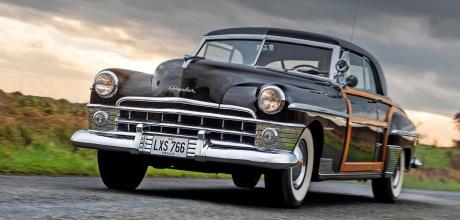1950 Chrysler Town & Country Newport Coupé
Built for one year, the Chrysler Town & Country Newport Coupe was the last of marque’s true ‘woodies’. We drive one in the UK, and we’re stirred by its sense of wanderlust.Words Rob Scorah.Photography Jonathan Jacob.
ASH TO ASHES
A jaunt in Chrysler’s last true luxury ‘woodie’, the Newport Town & Country
Chrysler’s last gasp of Forties luxury: the Newport woodie
Look at that; that swathe of chrome, the way it rolls across the dashboard. I’d opened the big heavy door of this 1950 Chrysler Town and Country, turning a handle that weighed and resisted just enough to tell me of its quality and manufacture, slid across the wide and ample bench seat, pulling myself into position with a steering wheel that almost spanned my shoulders. I was just going to put the key in the ignition, about to start the engine, when I became transfixed by the fullon, silver-on-black Art Deco-ness of the dashboard. It’s like the side of some Chicago-to-New York streamliner express rushing across in front of me; a wash of bright, ribbed metal. In the middle sits the radio, its outline stamped into the steel, and its solid-looking, round-cornered and indented block buttons sitting square between two heavy knurled knobs. All that sits above another impressive set of thick-set knobs and sliders that have an air of both mystery and precision, but which turn out to be merely the heating controls. But nothing is ‘merely’ anything inside the Chrysler Town and Country Newport Coupe, to give it its full Sunday name.
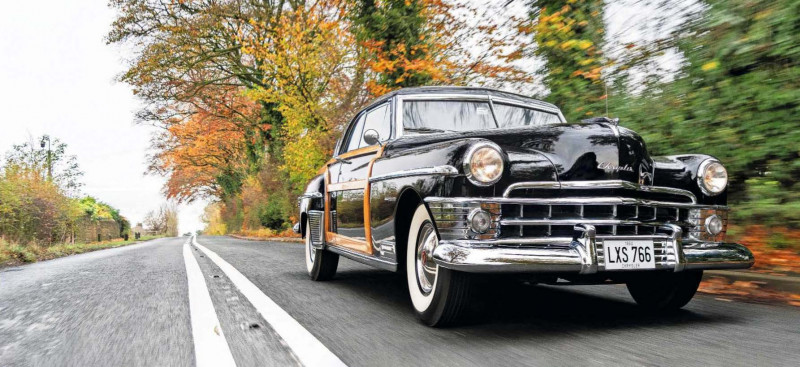
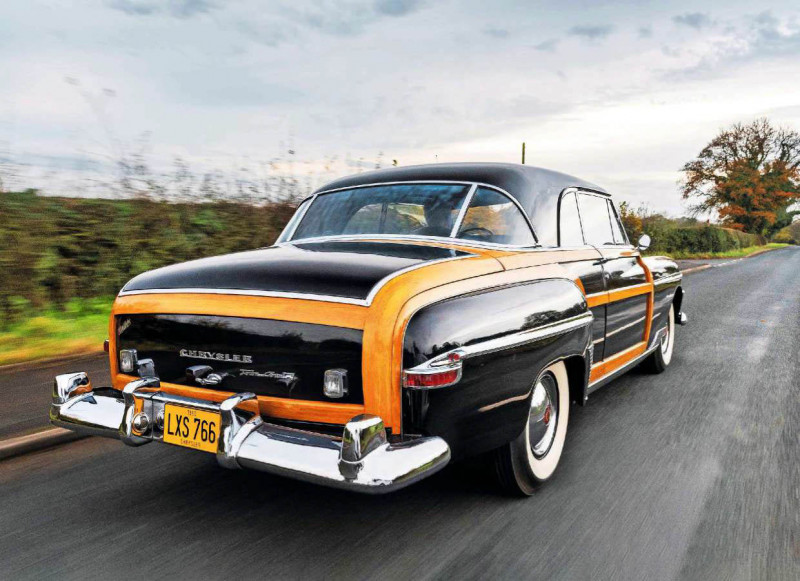
Everything is deliberate, slightly mannered, a little theatrical – a little Kitsch even. It’s not even really Fifties – I can feel the resonant echoes of the pre-War Chrysler Building in that instrument cluster. It’s like Bauhaus never happened. Though to be fair, you could say that of any Rolls-Royce or Jaguar of the period – or two decades later, for that matter.
‘I’m doing a lot of turning in relation to how many degrees the winged mascot traverses the horizon’
Still, who cares? And there’s another feeling I get sitting here looking at all this; it reminds me of that unforgettable moment as a child; the first time you ever sit behind the steering wheel of a real car, when all the controls are fascinating and exciting – even the cigarette lighter. Are my feet touching the floor?
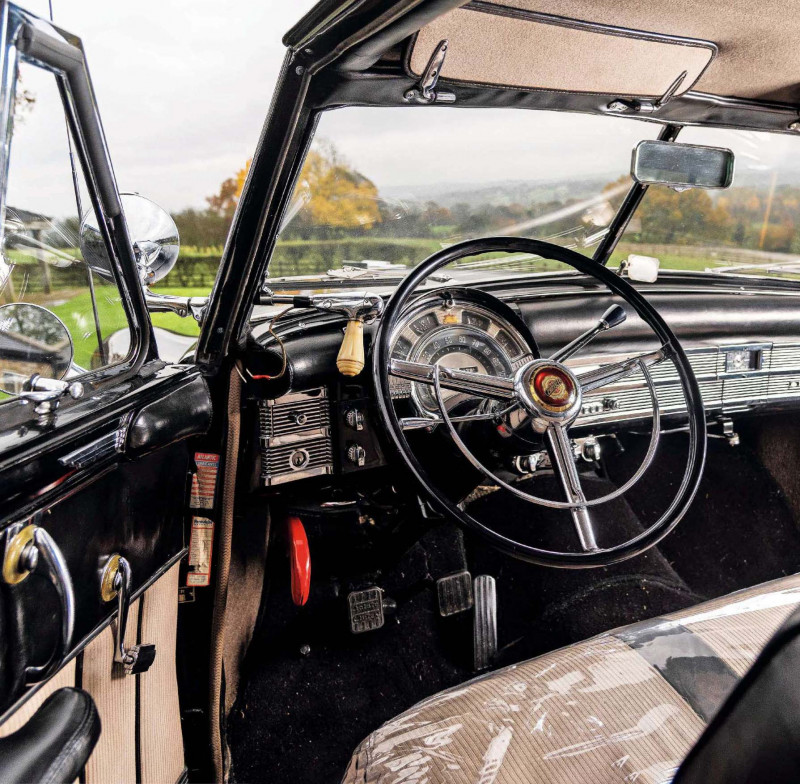
I’m not sure that was the feeling Chrysler wanted to elicit when you slid behind the wheel of the Newport Coupe for the first time, but it certainly wanted you to be impressed and excited. The Town and Country was derived from the New Yorker, Chrysler’s flagship model. Both inside and outside, the senior brand of the corporation had laid on every styling significator, a few of them contradictory, to tell you the car’s status and story. Then and now, the Newport was a proper car and an imposing beast. Staring out over that big domed bonnet you know that. Don’t let the Coupe name mislead you; it’s as big as a Fifties Rolls-Royce Silver Cloud – I have one nearby for reference. It’s not one of those that’s going to ‘shrink around you’ either. Still gazing at a chromed winged bonnet mascot that looks yards away, I turn the key wondering what noise will come from an engine that needs that big a hood.
‘It quickly relaxes into long straights, rolling gently in the turns’
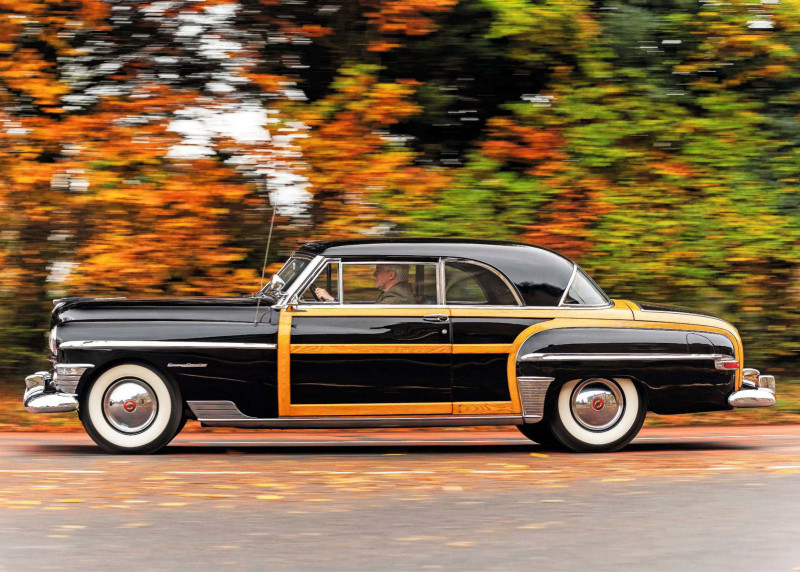
After a muted whump from the starter motor, the engine fires and settles into a low, reserved thrum. It surprises me; I think I was expecting the deep snarl of a Hemi V8 – my more usual experience of later Mopar, or maybe the grunt of Fifties Dodges I’ve met, decked out in full battle dress and spoiling for a fight on the dusty roads of the Carrera Panamericana. The Newport’s motor is sounding altogether more urbane and less obtrusive – you wouldn’t want the new car to frighten Audrey and the boys even before you’d begun the drive to the Catskills, after all.
‘It’s as big as a Silver Cloud, and it’s not going to shrink around you’
Anyway; this motor is a straight eight; the so-called Spitfire with an ‘L-Head’ – take a look at the exhaust manifold and you’ll see why. It was of a lineage of Chrysler fours, sixes and eights that went all the way back to 1924, though the eight didn’t appear until 1949. And while right from 1932, when folk were already getting worked up about Ford’s ‘flathead’ V8, many still preferred the effortless low-down torque and sophisticated manners of the in-line engines. I’m kind of getting that – our girl is pulling away very smoothly with no fuss, setting off in a calm manner.
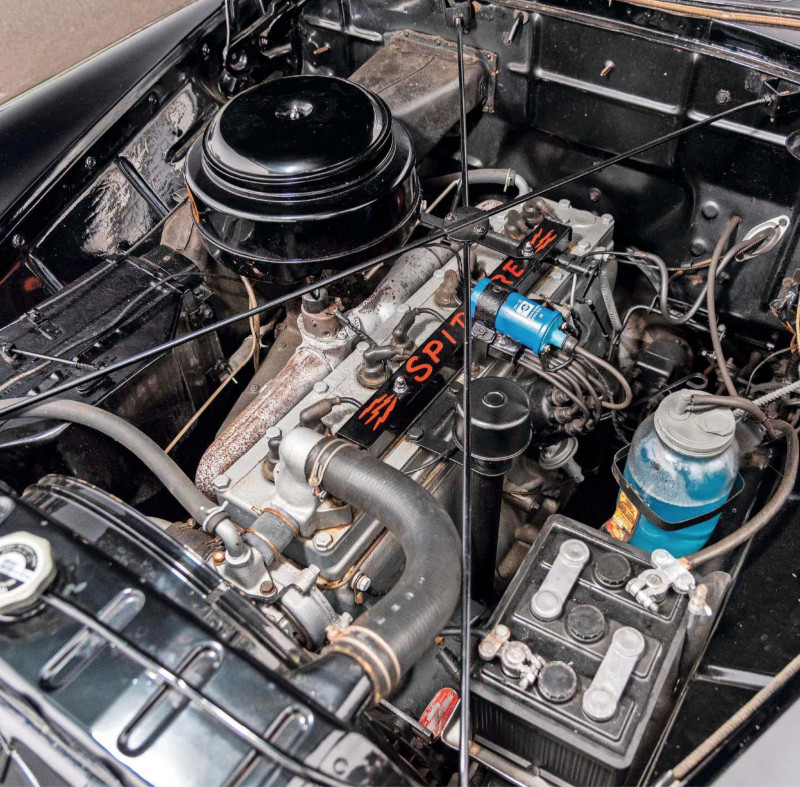
Well… the car may be calm, but if you’ve never driven one of these before, you may have some adjusting to do as a driver getting the hang of this Chrysler’s clever semi-automatic transmission. Arrayed in front of you on the floor are the usual three pedals, widely-spaced and relatively high. And to the right of the steering wheel there is a substantial, long and long-throw column-shift lever – more of a beam – which, in conjunction with the clutch, you push up to get into the low ratios. All goes smoothly – well, firm shove, clunkily smoothly – and the Chrysler sets off with not much more than a burr from that seemingly far-off motor. It’s eager to get out of its lowest gear.
Letting off the throttle gives the ’box it’s prompting to change up via a hydraulic piston – without recourse to the clutch – but it’s pretty quickly through second too. Now you’re at the point when you need the clutch again, to get into ‘high’ or third/fourth or whatever you want to call it. So; clutch in and pull the long lever right down – a long movement with a slight extra shove at the end. The gear selector feels distanced from the action, though I’m comparing it – probably very unfairly – to Mercedes column shifts of a few years later. Even so, on the move, this soon becomes a fairly swift operation.
Once in ‘high’ the Newport can be driven like a full automatic, even stopping and starting again without shifting to ‘low’ if you’re willing to go with its more leisurely take-off speeds thanks to the Fluid Drive coupling ahead of the clutch. But it’s not a torque converter. Again, as you step up in high to ‘fourth’, it’s just a quick lifting of the throttle when you get to the high(er) revs. Somewhere from the bowels of the ship you’ll hear a clunk. It doesn’t even complain if you forget to lift off between gears. Navigating country lanes actually gives you a false impression of how one of these cars motors. The constant recourse for ‘low’ via the clutch and shifter for tight narrow turns was probably not often in the Newport’s remit and, to be fair, ‘high’ seems well able to deal with most situations. And the car will stop too, though granted in that characteristically big-boat, Fifties manner.
The brakes were actually one of the most modern features of this essentially Forties car and were a usually a $400 option only available on Chrysler’s top models, though the Newport received them as standard equipment. Designed by Ausco-Lambert (aka Auto Specialties Manufacturing Company), they look like big finned drums, but inside the casing is a pair of discs which, when you depress the pedal, are pushed apart, its friction pads pressing against the inside of the drum. Inside, steel balls further move to wedge the disc apart, amplifying the stopping power – I’m not convinced you can feel that – and these are retracted when you release the pedal. All a bit involved, but effective. Back on the power, the car soon relaxes into straights, rolling gently in the turns and keeping a poised low-key demeanour as if it’s settling in for a long haul. Like so many big tourers – from both sides of the Atlantic – it’s an open-roads animal.
It’s one of those cars where you enjoy the going rather than the driving, looking at the landscape ahead and wanting to push on to see more. You’re also enjoying it from the railroad observation car-like ambience of your Art Deco Salon. The Newport was a lot more sybaritic and stylish than its predecessors. Whereas in a ’48 Town & Country, with its tartan seats and far more rudimentary door cards, you may have felt fine driving off on a hunting trip in your red and black plaid patch-pocket jacket – with matching trapper’s hat of course (we draw the line at a moose tied to the roof rack) – this car is more blazer and flannels, with Audrey in a twin set, cardigan over her shoulders. But that ’48 and this Newport Coupe share a common if tenuous lineage in one respect; both are examples of Chrysler’s illustrious woodies.
Of course, the woody was and remains an American archetype, redolent with images of packing the family in and crossing the country to visit the national parks or going off on said hunting trips into misty pine-covered mountain ranges. Their appearance harked back to slower times, to a literal meaning of the term coachbuilding, when vehicles were hand-built by craftsmen. Take a look at that ’48 T&C sedan again, or the Packard Super Eight woody wagon of the same year – there is some serious panelling in evidence.
By 1950, most of the decorative wood had been discarded. The Newport Coupe more implies its lineage of hand-crafted tradition – yes, you may raise an eyebrow – with a simple outline wood ‘frame’. It gives the car a warmer look. It’s a little more informal; a tweed suit rather than double-breasted pinstripe. And when you parked up at one of the stout stone inns of Yellowstone park to unload, or even just at the golf club, that butterscotch-warm white ash, so beautifully curved with its expert dovetail joins, just helped to let everyone know that you paid a little bit more for carrying on that tradition.
Actually, you would have paid a lot more; the Newport carried a sticker price of $4007, several hundred dollars more than the top Cadillac and Lincoln coupés of the year. The expensive Newport sold, but it was probably the last year that the market could accommodate such a product. Chrysler boss KT Keller’s insistence that there should be enough room in his highsitting cars for a gentleman keep his top hat on was a notion of a bygone age. The GM product was starting to move, perhaps imperceptibly in its cleanness of line and function towards the jet age or the rocket age… In this Chrysler, probably then as now, I’m getting more of a ‘great age of travel’ vibe – a bit more Forties.
I’m reminded of some of the great American magazine print ads from the likes of Packard and Hudson; families being waved away from large English-style country houses, everyone in the car wearing thick coats, hats and gloves. There’s certainly room for that in here – none of yer ‘change your shoes to drive a Caterham’ rubbish. I could readily wear some pretty stout brogues and a long coat. Thick gloves – no problem – I would still easily grip the chunky controls, though I do value some elbow room (sorry Audrey) to handle that steering. On tight bends, maybe back in the Catskills, it can get a bit…vigorous.
Actually, I’m not totally sure how the steering connects. Like all big, sleepy barges there’s a latency, that moment’s thought before the front wheels begin to move. I seem to be doing an awful lot of turning in relation to how many degrees the winged mascot traverses the horizon. It’s like the wheel merely actions a sign down in the steering room that tells whoever operates the system to make a turn. Right, left, ramming speed… As I reach a series of shallow, uphill corners, I’m reminded of my very limited experience of steering an ocean-going racing yacht; that turning of the wheel, hand over hand, and then the waiting for something to happen. You learn to begin the movement before the change in the road. It doesn’t matter, because the Newport doesn’t entice you into making a charge for the next bend, unlike that mischievous Dodge on the Carrera, you just settle into its way of travelling, planning a long route to take advantage of its inherent if quiet wanderlust. There’ll be lots of stops – to look at the mountains still ahead and to simply sit and admire that ‘Streamline Moderne’ locomotive split windshield or all that sculptural chrome; a poetic manifestation of how the air moves across the car. In this rush-everywhere age, there’s a lot of satisfaction to be found in that kind of travelling.
Chrysler didn’t produce a convertible version in 1950. The steel-roofed coupé was probably already a slight anachronism by the time it was made, though we can’t feel that now. In total 698 were built; perhaps 80 survive. The T&C name passed on to a range of unadorned steel-bodied station wagons and then to a range of anodyne minivan/people carriers. It brings a slight frown and a melancholy smile when you see one of those – with plastic wood panels on the side. If you’re going to take a trip, to really travel, do it right.
TECHNICAL DATA 1950 Chrysler Town & Country Newport Coupé
- Engine 5302cc sidevalve in-line eight cylinder, Carter dual downdraft carburettor
- Power & Torque 135bhp @ 3400rpm; 270lb ft @ 1600rpm
- Transmission Four-speed Fluid Drive manual transmission, rear-wheel-drive
- Steering Worm and sector
- Suspension Front: independent, wishbones, coil springs. Rear: solid axle, semi-elliptical springs
- Brakes Servo discs all round
- Weight 1620kg (3600lb)
- Performance 0-60mph: 23.7sec.
- Top speed: 86mph
- Cost new $4007 (£1431)
- Value now £27,000 approx.
Ash framework is non-structural; craftsmanship and rich varnish has allowed it to last decades. The 5.3-litre Spitfire straight-eight delivery of modest but silky-smooth power suits the car perfectly.
Chrome hubs hide innovative but complex discs-within-drums braking system Fold-out convenience tray. In case Audrey needs to… powder her nose? Newport name used to designate fixed hardtop configuration Essential equipment for your marauding through the Catskills Never intended at a volume-seller for its conglomerate parent.
Driving position sets tone for languorous dynamic experience. The Town & Country name lost its lustre after the 1950 model
Fluid Drive transmission operates via a clutch pedal and column stalk
Its 5665mm length made the Newport the longest American two-door of its era
Owning a Newport Coupe
‘I’d actually gone down to look for a Morgan,’ says owner Russell Morgan, about how he came to meet the Chrysler at Historics’ Ascot sale in 2021. ‘I saw the Chrysler and I thought it looked amazing. I kept having to look twice.’ He went on browsing the auction stock but kept coming back to the Chrysler.
‘I kept walking past this thing. I got quite giddy about it and I fell in love with it; the shape and the feel of the car.’ So although he did return home with a car with a wood frame – of sorts – it wasn’t the one he expected. However, on its first trip out back up in Lancashire, the Chrysler’s brakes gave out. ‘They suddenly locked on and didn’t release. They were overheating – and they weren’t cooling off.’ Apparently the inside of the brake lines had deteriorated and clogged – and a new set was in order. ‘The car actually has massive discs, set inside large drums,’ Morgan explains. Once fixed, he was all set to get to know the car better.
‘It’s a great touring car, and of course all the windows come down – it’s a proper pillarless coupé. It can be very open. For a 1950 car, it drives as well as my [Sixties] Rolls-Royce Silver Cloud, though granted, with masses of roll in the corners. There’s no power steering, but it isn’t heavy, though there is lots of lock.’
Unlike the Rolls, which he says gets largely ignored, the Town and Country gets lots of attention from other road users. ‘At traffic lights, people wind down their windows and just go, “Wow”.’


